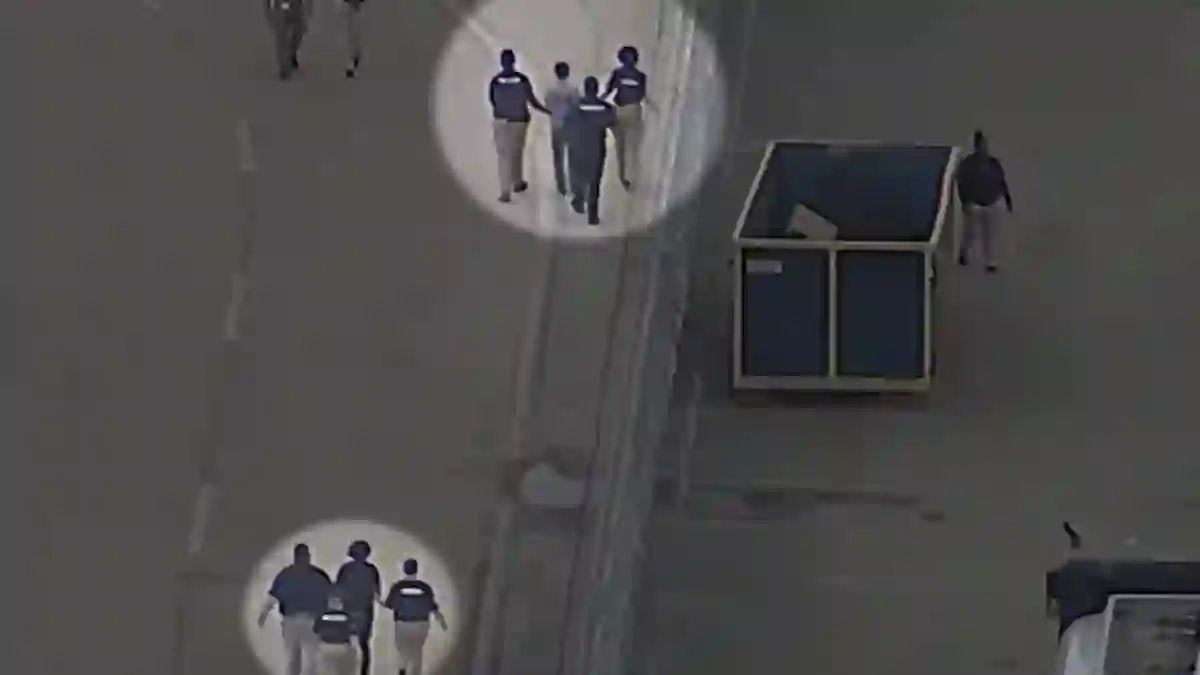President Trump’s newly built migrant detention facility, nicknamed the ‘Alligator Alcatraz,’ has officially started taking in its first detainees.
But the location in the Florida Everglades—known for its wild terrain and frequent heavy rains—is already raising alarms about flooding risks.
First Detainees Arrive Despite Weather Worries
Footage from NBC Miami shows two handcuffed migrants being escorted into the remote center deep within the Everglades.
The Florida Division of Emergency Management and Republican Attorney General James Uthmeier’s office confirmed that the first group arrived earlier this week.
Attorney General Uthmeier, who is credited with designing the facility, posted on X: “Next stop: back to where they came from,” highlighting the state’s tough stance on immigration.
Built to Withstand Storms but Flooding Already Hits
The detention center is located in an area prone to heavy thunderstorms, and flooding had already affected the tents there on Tuesday during President Trump’s opening visit.
State officials insist the facility can handle a Category 2 hurricane—winds between 96 and 110 mph—and say contractors worked overnight to fix flooding damage.
DeSantis and Officials See Location as Deterrent
Governor Ron DeSantis and other state leaders emphasize the remote, rugged location as part of a strategy to discourage migrants from trying to escape.
The Everglades are teeming with millions of alligators, making the facility’s surroundings as dangerous as its security measures.
DeSantis named the center ‘Alligator Alcatraz,’ comparing it to the infamous federal prison on Alcatraz Island, which was famously escape-proof thanks to its isolated position surrounded by shark-infested waters.
Signs and Seizure of Land Mark New Facility
Images shared with the Associated Press reveal workers putting up ‘Alligator Alcatraz’ signs along the only highway leading to the site and near the Dade-Collier Training and Transition Airport, where the facility is located.
The state used emergency powers via an executive order to seize the county-owned land for the center, which was constructed in just eight days.
Facility Details: Capacity, Staff, and Security
The detention center is built on an airport training site and initially houses about 3,000 detainees, with plans to expand to 5,000 beds by early July.
Governor DeSantis says the facility will be staffed by roughly 1,000 personnel, with more than 200 security cameras, over 28,000 feet of barbed wire fencing, and 400 security officers on site.
Migrants Held Under Federal 287(g) Program
Migrants arrested by Florida law enforcement under the federal 287(g) program—which authorizes local police to detain immigrants for ICE—will be brought to this center.
The program allows police to interrogate detainees and potentially hold them for deportation.
Democratic Lawmakers Visit Amid Concerns Over Conditions and Contracts
On Thursday, a group of Florida Democratic lawmakers conducted an official visit to the facility, expressing worries about detainee conditions and the state contracts awarded to build the center.
President Trump’s newly built migrant detention facility, nicknamed the ‘Alligator Alcatraz,’ has officially started taking in its first detainees.
But the location in the Florida Everglades—known for its wild terrain and frequent heavy rains—is already raising alarms about flooding risks.
First Detainees Arrive Despite Weather Worries
Footage from NBC Miami shows two handcuffed migrants being escorted into the remote center deep within the Everglades.
The Florida Division of Emergency Management and Republican Attorney General James Uthmeier’s office confirmed that the first group arrived earlier this week.
Attorney General Uthmeier, who is credited with designing the facility, posted on X: “Next stop: back to where they came from,” highlighting the state’s tough stance on immigration.
Built to Withstand Storms but Flooding Already Hits
The detention center is located in an area prone to heavy thunderstorms, and flooding had already affected the tents there on Tuesday during President Trump’s opening visit.
State officials insist the facility can handle a Category 2 hurricane—winds between 96 and 110 mph—and say contractors worked overnight to fix flooding damage.
DeSantis and Officials See Location as Deterrent
Governor Ron DeSantis and other state leaders emphasize the remote, rugged location as part of a strategy to discourage migrants from trying to escape.
The Everglades are teeming with millions of alligators, making the facility’s surroundings as dangerous as its security measures.
DeSantis named the center ‘Alligator Alcatraz,’ comparing it to the infamous federal prison on Alcatraz Island, which was famously escape-proof thanks to its isolated position surrounded by shark-infested waters.
Signs and Seizure of Land Mark New Facility
Images shared with the Associated Press reveal workers putting up ‘Alligator Alcatraz’ signs along the only highway leading to the site and near the Dade-Collier Training and Transition Airport, where the facility is located.
The state used emergency powers via an executive order to seize the county-owned land for the center, which was constructed in just eight days.
Facility Details: Capacity, Staff, and Security
The detention center is built on an airport training site and initially houses about 3,000 detainees, with plans to expand to 5,000 beds by early July.
Governor DeSantis says the facility will be staffed by roughly 1,000 personnel, with more than 200 security cameras, over 28,000 feet of barbed wire fencing, and 400 security officers on site.
Migrants Held Under Federal 287(g) Program
Migrants arrested by Florida law enforcement under the federal 287(g) program—which authorizes local police to detain immigrants for ICE—will be brought to this center.
The program allows police to interrogate detainees and potentially hold them for deportation.
Democratic Lawmakers Visit Amid Concerns Over Conditions and Contracts
On Thursday, a group of Florida Democratic lawmakers conducted an official visit to the facility, expressing worries about detainee conditions and the state contracts awarded to build the center.
President Trump’s newly built migrant detention facility, nicknamed the ‘Alligator Alcatraz,’ has officially started taking in its first detainees.
But the location in the Florida Everglades—known for its wild terrain and frequent heavy rains—is already raising alarms about flooding risks.
First Detainees Arrive Despite Weather Worries
Footage from NBC Miami shows two handcuffed migrants being escorted into the remote center deep within the Everglades.
The Florida Division of Emergency Management and Republican Attorney General James Uthmeier’s office confirmed that the first group arrived earlier this week.
Attorney General Uthmeier, who is credited with designing the facility, posted on X: “Next stop: back to where they came from,” highlighting the state’s tough stance on immigration.
Built to Withstand Storms but Flooding Already Hits
The detention center is located in an area prone to heavy thunderstorms, and flooding had already affected the tents there on Tuesday during President Trump’s opening visit.
State officials insist the facility can handle a Category 2 hurricane—winds between 96 and 110 mph—and say contractors worked overnight to fix flooding damage.
DeSantis and Officials See Location as Deterrent
Governor Ron DeSantis and other state leaders emphasize the remote, rugged location as part of a strategy to discourage migrants from trying to escape.
The Everglades are teeming with millions of alligators, making the facility’s surroundings as dangerous as its security measures.
DeSantis named the center ‘Alligator Alcatraz,’ comparing it to the infamous federal prison on Alcatraz Island, which was famously escape-proof thanks to its isolated position surrounded by shark-infested waters.
Signs and Seizure of Land Mark New Facility
Images shared with the Associated Press reveal workers putting up ‘Alligator Alcatraz’ signs along the only highway leading to the site and near the Dade-Collier Training and Transition Airport, where the facility is located.
The state used emergency powers via an executive order to seize the county-owned land for the center, which was constructed in just eight days.
Facility Details: Capacity, Staff, and Security
The detention center is built on an airport training site and initially houses about 3,000 detainees, with plans to expand to 5,000 beds by early July.
Governor DeSantis says the facility will be staffed by roughly 1,000 personnel, with more than 200 security cameras, over 28,000 feet of barbed wire fencing, and 400 security officers on site.
Migrants Held Under Federal 287(g) Program
Migrants arrested by Florida law enforcement under the federal 287(g) program—which authorizes local police to detain immigrants for ICE—will be brought to this center.
The program allows police to interrogate detainees and potentially hold them for deportation.
Democratic Lawmakers Visit Amid Concerns Over Conditions and Contracts
On Thursday, a group of Florida Democratic lawmakers conducted an official visit to the facility, expressing worries about detainee conditions and the state contracts awarded to build the center.



